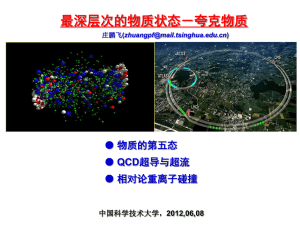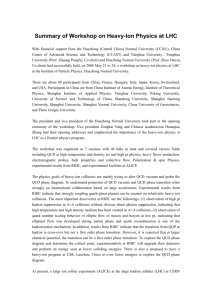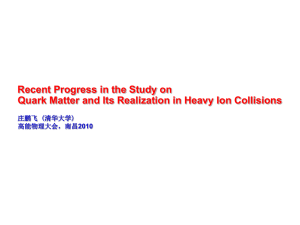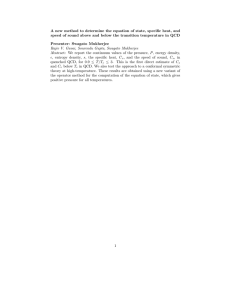Exploring Hot Dense Matter at RHIC and LHC Peter Jacobs
advertisement
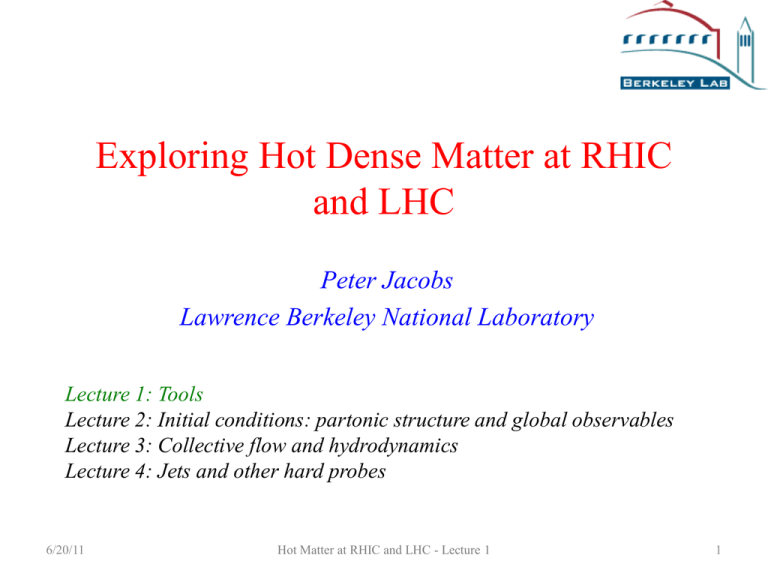
Exploring Hot Dense Matter at RHIC and LHC Peter Jacobs Lawrence Berkeley National Laboratory Lecture 1: Tools Lecture 2: Initial conditions: partonic structure and global observables Lecture 3: Collective flow and hydrodynamics Lecture 4: Jets and other hard probes 6/20/11 Hot Matter at RHIC and LHC - Lecture 1 1 My approach to these lectures The field of hot QCD matter is vast, spanning the boundaries of nuclear, particle and condensed matter physics, and string theory The field is also relatively young, with many phenomena not yet understood on a fundamental level • this is an opportunity, but also a barrier to the newcomer to sort out what is really known and what is conjectured I will make no attempt to be comprehensive • rather, I will discuss a limited number of topics that are wellestablished experimentally and have a clear connection to wellfounded theory I am not an expert in all the topics I will present. Ask lots of questions, and those I don’t understand we will figure out together 6/20/11 Hot Matter at RHIC and LHC - Lecture 1 2 References QCD • Particle Data Group topical reviews http://pdg.lbl.gov/2004/reviews/contents_sports.html • QCD and jets: CTEQ web page and summer school lectures http://www.phys.psu.edu/~cteq/ • Handbook of Perturbative QCD, Rev. Mod. Phys. 67, 157–248 (1995) • QCD and Collider Physics, R. K. Ellis, W. J. Sterling, D.R. Webber, Cambridge University Press (1996) Heavy Ion Physics • Results from the Relativistic Heavy Ion Collider, B. Mueller and J. Nagle; Ann. Rev. Nucl. Part. Sci. 56, 93 (2006), nucl-th/0602029 • Heavy Ion Collisions at the LHC – Last Call for Predictions, N. Armesto et al. (ed).; J. Phys. G35 054001 (2008), arXiv:0711.0974 • New Developments in Relativistic Viscous Hydrodynamics, P. Romatschke; Int. J. Mod. Phys. E19, 1-53 (2010), arXiv:0902.3663 • The theory and phenomenology of perturbative QCD-based jet quenching, A. Majumder and M. van Leeuwen; arXiv:1002.2206 • Gauge/String Duality, Hot QCD and Heavy Ion Collisions, J. CasalderreySolana et al.; arXiv:1101.0618 The major heavy ion conference: Quark Matter (http://qm2011.in2p3.fr/node/18) Hot Matter at RHIC and LHC - Lecture 1 6/20/11 3 Outline: Lecture 1 Theory Tools •Basics of QCD •Finite Temperature QCD Experimental Tools •Colliders •Detectors Analysis Tools •Relativistic Kinematics •Characterization of nuclear collisions 6/20/11 Hot Matter at RHIC and LHC - Lecture 1 4 Quark→hadron transition happened at ~10-6 s Relics could be visible for a strongly first-order transition e.g. local baryon number fluctuations affect primordial nucleosynthesis → appears not to be the case ;-( 6/20/11 Hot Matter at RHIC and LHC - Lecture 1 5 Outline: Lecture 1 Theory Tools •Basics of QCD •Finite Temperature QCD Experimental Tools •Colliders •Detectors Analysis Tools •Relativistic Kinematics •Characterization of nuclear collisions 6/20/11 Hot Matter at RHIC and LHC - Lecture 1 6 Quantum Chromo-dynamics: the field theory of the strong (nuclear) force Same basic structure as QED (electromagnetism)…. ….except that gluons (“photons” of strong force) carry (color) charge… ….so they interact among themselves, generating much more complex structures… 6/20/11 Hot Matter at RHIC and LHC - Lecture 1 7 Field theory: “running” of the coupling Consider the interaction of two elementary particles: Momentum transfer Q2 Q2 small Q2 large distance scales large Q2 small distance scales Quantum mechanics: Virtual pairs (loops) screen bare interaction momentum-dependent interaction strength 6/20/11 Hot Matter at RHIC and LHC - Lecture 1 8 Running of the coupling: QED vs QCD 2 g 4 QED: negative 2 1 1 1 |Q | log 2 2 2 Q 3 Smaller |Q2| (larger distance) weaker coupling • similar to screening of charge in di-electric material QCD: 11N color 2n flavor | Q2 | 1 1 log 2 2 2 S Q S 12 =+(33-12)/12 = positive! Smaller |Q2| (larger distance) larger coupling Hot Matter at RHIC and LHC Lecture 1 And that makes a huge difference! 9 QCD: running of S Asymptotic Freedom Rcone 2004 Nobel Prize Confinement Q Q Gross 0.2 fm 6/20/11 Low momentum Politzer 0.02 fm Wilczek 0.002 fm High momentum Hot Matter at RHIC and LHC - Lecture 1 10 Now let’s think about “matter” compress phase transitions Phase diagram of QCD (simplified) heat Phase diagram of water (simplified) phase transition? You are here heat 6/20/11 compress Hot Matter at RHIC and LHC - Lecture 1 11 Quantitative QCD thermodynamics QCD calculated on the lattice (B=0) Slow convergence to non-interacting Steffan-Boltzmann limit What carries energy - complex bound states of q+g? “strongly-coupled” plasma? 2 S. Borsanyi et al., JHEP 1011, 077 (2010) 4 g T DOF Energy density 30 T 4 Cross-over, not sharp phase transition (like ionization of atomic plasma) 6/20/11 Temperature [MeV] Hot Matter at RHIC and LHC - Lecture 1 12 Exploration of hot QCD Matter: what are the questions? (partial list) What is the nature of QCD Matter at finite temperature? • What is its phase structure? • What is its equation of state? • What are its effective degrees of freedom? • Is it a (trivial) gas of non-interacting quarks and gluons, or a fluid of interacting quasi-particles? • What are its symmetries? • Is it correctly described by Lattice QCD or does it require new approaches, and why? What are the dynamics of QCD matter at finite temperature? • What is the order of the (de-)confinement transition? • How is chiral symmetry restored at high T, and how? • Is there a QCD critical point? • What are its transport properties? Can QCD matter be related to other physical systems? Can we study hot QCD matter experimentally? Hot Matter at RHIC and LHC - Lecture 1 6/20/11 13 Studying hot QCD in the Laboratory: high energy collisions of heavy nuclei Model calculation 6/20/11 Hot Matter at RHIC and LHC - Lecture 1 14 Measurements with telescopes Evolution of the Early Universe Measurements with colliders Evolution of a Heavy Ion Collision 6/20/11 Hot Matter at RHIC and LHC - Lecture 1 15 Experimental exploration of hot QCD Matter: what are the issues? Intensive thermodynamic quantities (T, P, ,,) are only defined for systems in (quasi- or local-) equilibrium • QCD Lattice calculates equilibrated matter (e.g. at fixed T) But nuclear collisions are highly dynamic: • “Fireball” starts blowing apart the instant it is generated • Fireball lifetime ~ few fm/c • no a priori reason that quasi-equlibration should be achieved on this time-scale No ab initio theory to describe full dynamical evolution of the fireball 6/20/11 Hot Matter at RHIC and LHC - Lecture 1 16 Experimental study of hot QCD Matter: Strategy Experiment: • No ab initio theory interpretation via comparison to reference systems: p+p, p/d+A, light ion collisions,… • Vary system size: quantitative control over collision geometry • Choose observables with close connection to theory and controlled modeling • Over-determined measurements: multiple, systematically ~independent observables sensitive to the same underlying physics Theory: models and effective theories for different stages of fireball evolution • initial state: modified pdfs, saturation models,… • hard probes: pQCD-based modeling • collective expansion: viscous relativistic hydrodynamics • hadronic phase: detailed Monte Carlos Experiment+Theory: • detailed comparison and mutual calibration 6/20/11 Hot Matter at RHIC and LHC - Lecture 1 • evolution with √s: RHIC vs LHC 17 6/20/11 Hot Matter at RHIC and LHC - Lecture 1 18 Outline: Lecture 1 Theory Tools •Basics of QCD •Finite Temperature QCD Experimental Tools •Colliders •Detectors Analysis Tools •Relativistic Kinematics •Characterization of nuclear collisions 6/20/11 Hot Matter at RHIC and LHC - Lecture 1 19 The Relativistic Heavy Ion Collider Brookhaven National Laboratory 20 6/20/11 Hot Matter at RHIC and LHC - Lecture 1 The Relativistic Heavy Ion Collider (BNL) STAR 21 6/20/11 Hot Matter at RHIC and LHC - Lecture 1 STAR and PHENIX at RHIC PHENIX STAR STAR PHENIX 2 coverage, -1 < h < 1 for tracking + (coarse) EMCal Partial coverage 2 x 0.5, -0.35 < h < 0.35 Finely segmented calorimeter + forward muon arm PID by TOF, dE/dx (STAR), RICH (PHENIX) Optimised for acceptance (correlations, jet-finding) 6/20/11 Optimised for high-pt 0, g, e, J/y (EMCal, high trigger rates) (PHOBOS, BRAHMS more Hot Matter at RHIC and LHCspecialised) - Lecture 1 22 Large Hadron Collider at CERN 6/20/1123 Hot Matter at RHIC and LHC - Lecture 1 Large Hadron Collider at CERN p+p at √s=7 (14) TeV Pb+Pb at √s=2.76 (5.5) TeV heavy ion running: 4 physics weeks/year CMS LHCb ATLAS ALICE 24 6/20/11 Hot Matter at RHIC and LHC - Lecture 1 US is single largest national community 6/20/11 Hot Matter at RHIC and LHC - Lecture 1 25 CERN: “where the web was born’’ World’s first web server (NEXT workstation, 1991) Invention of HTML (Tim Berners-Lee, 1991) First IP router in Europe 6/20/11 Hot Matter at RHIC and LHC - Lecture 1 26 LHC Detectors for Heavy Ions ALICE CMS ATLAS (not to scale: RATLAS>RCMS >RALICE ) 6/20/11 Hot Matter at RHIC and LHC - Lecture 1 27 ATLAS May 2007 (under construction) People 6/20/11 Hot Matter at RHIC and LHC - Lecture 1 28 ATLAS November 2006 (under construction) Person 6/20/11 Hot Matter at RHIC and LHC - Lecture 1 29 ALICE ALICE is the comprehensive heavy ion experiment at the LHC Design optimized for •huge particle multiplicities of nuclear collisions •efficient tracking over wide momentum range •extensive particle identification 6/20/11 Hot Matter at RHIC and LHC - Lecture 1 30 CMS cross section 6/20/11 Hot Matter at RHIC and LHC - Lecture 1 31 November 7 2010: First Pb+Pb collisions at √sNN=2.76 TeV 6/20/11 Hot Matter at RHIC and LHC - Lecture 1 32 CMS detector performance: di-muon invariant mass spectrum p+p 7 TeV QCD charm beauty Four decades of particle physics in one plot Hot Matter at RHIC and LHC 6/20/11 Lecture 1 33 Electro-weak unification Detector Performance ALICE Particle ID (TPC dE/dx) Copious production of anti-nuclei 6/20/11 Hot Matter at RHIC34 and LHC - Lecture 1 ALICE: Tomography via g-conversions Compare data and MC Inner material understood better than 10% 6/20/11 Hot Matter at RHIC and LHC - Lecture 1 Mgg 35 First LHC Scientific Publication (Dec ’09) 6/20/11 Hot Matter at RHIC and LHC - Lecture 1 36 Full ALICE author and institution list… ATLAS and CMS are ~2x larger 6/20/11 Hot Matter at RHIC and LHC - Lecture 1 37 Outline: Lecture 1 Theory Tools •Basics of QCD •Finite Temperature QCD Experimental Tools •Colliders •Detectors Analysis Tools •Relativistic Kinematics •Characterization of nuclear collisions 6/20/11 Hot Matter at RHIC and LHC - Lecture 1 38 Kinematics for Inclusive Reactions Rapidity E p|| y ln E p || 1 2 p|| dN/dy Rapidity is differentially boost-invariant Pseudo-rapidity Invariant production cross section 6/20/11 pT y h ln tan 2 Distribution invariant with longitudinal boost y for m/p <<1 d 3 d 2 E 3 d p 2pT dydpT Hot Matter at RHIC and LHC - Lecture 1 39 Nuclear geometry and hard processes: Glauber theory Glauber scaling: hard processes with large momentum transfer • short coherence length successive NN collisions independent • p+A is incoherent superposition of N+N collisions Normalized nuclear density r(b,z): dz db b, z 1 Nuclear thickness function TA b dz b, z Inelastic cross section for p+A collisions: 6/20/11 Hot Matter at RHIC and LHC - Lecture 1 40 Experimental tests of Glauber scaling: hard cross sections in p()+A collisions Glauber scaling: inel for 7 GeV muons on nuclei hard pA A hard NN Drell-Yan/A in p+A at SPS M.May et al, Phys Rev Lett 35, 407 (1975) qq A1.00 NA50 Phys Lett B553, 167 A 6/20/11 Hard cross sections in p+A scale as A1.0 Hot Matter at RHIC and LHC - Lecture 1 41 Glauber Theory for A+B Collisions Nuclear overlap function: Average number of binary NN collisions for B nucleon at coordinate sB: Average number of binary NN collisions for A+B collision with impact parameter b: 6/20/11 Hot Matter at RHIC and LHC - Lecture 1 42 Measuring collision geometry I Nuclei are “macroscopic” characterize collisions by impact parameter Correlate particle yields from ~causally disconnected parts of phase space correlation arises from common dependence on collision impact parameter 6/20/11 Hot Matter at RHIC and LHC - Lecture 1 43 Measuring collision geometry II Forward neutrons • Order events by centrality metric • Classify into percentile bins of “centrality” HI jargon: “0-5% central” Connect to Glauber theory via particle production model: • Nbin: effective number of binary nucleon collisions (~510% precision) • Npart: number of (inelastically scattered) “participating” nucleons 6/20/11 Charged hadrons h~3 Hot Matter at RHIC and LHC - Lecture 1 44 Scaling of cross sections using Glauber theory plays a central role in quantitative analysis of experimental measurements and connection to theory. Let’s test it experimentally in A+A collisions… 6/20/11 Hot Matter at RHIC and LHC - Lecture 1 45 Glauber test at RHIC: Scaling of direct photon yield in p+p vs. Au+Au Direct g: Nbin-scaled inclusive yield PHENIX PHENIX, PRL 94, 232301 Centrality 6/20/11 DirectHot g yield scales Matter at RHIC and LHCwith - LectureN 1 bin 46 Glauber test at RHIC: Scaling of charm total production cross section PRL 94 (2005) NLO prediction: m ≈ 1.3 GeV, reasonably hard scale at pT=0 Total charm cross section scales with Nbin in A+A (Sizable disagreement between STAR and PHENIX ……?) 6/20/11 Hot Matter at RHIC and LHC - Lecture 1 47 Glauber test at LHC: Scaling of direct photon yield in p+p vs Pb+Pb Direct g yield scales with Nbin 6/20/11 Hot Matter at RHIC and LHC - Lecture 1 48 Glauber test at LHC: Scaling of Z boson yield in p+p vs Pb+Pb Z boson yield scales with Nbin 6/20/11 Hot Matter at RHIC and LHC - Lecture 1 49 Summary of Lecture 1: what are the questions? (partial list) What is the nature of QCD Matter at finite temperature? • What is its phase structure? • What is its equation of state? • What are its effective degrees of freedom? • Is it a (trivial) gas of non-interacting quarks and gluons, or a fluid of interacting quasi-particles? • What are its symmetries? • Is it correctly described by Lattice QCD or does it require new approaches, and why? What are the dynamics of QCD matter at finite temperature? • What is the order of the (de-)confinement transition? • How is chiral symmetry restored at high T, and how? • Is there a QCD critical point? • What are its transport properties? Can QCD matter be related to other physical systems? Can we study hot QCD matter experimentally? Hot Matter at RHIC and LHC - Lecture 1 6/20/11 50
